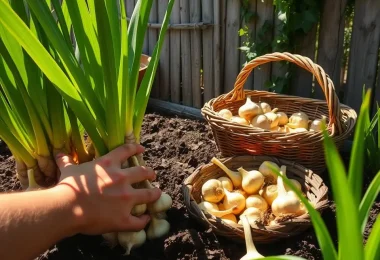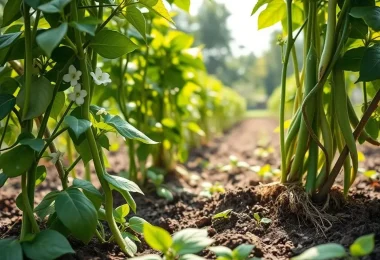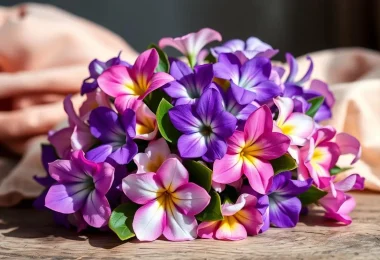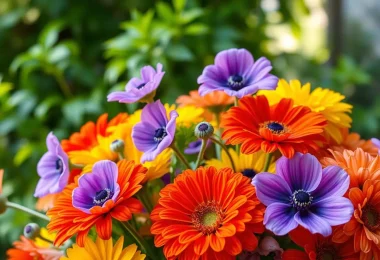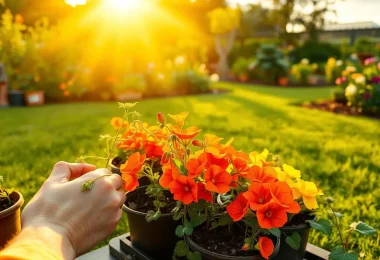Hyacinths are stunning spring flowers that bring color and scent to your garden or home. This guide is perfect for both new and experienced gardeners. It will teach you how to plant and care for these beautiful blooms.
We’ll show you how to pick the best bulbs and what growing conditions they need. You’ll learn all the key steps to make your hyacinths flourish. They will reward you with their gorgeous flowers.

Key Takeaways
- Hyacinths are easy-to-grow spring-flowering bulbs that offer vibrant colours and delightful fragrance.
- Selecting high-quality, healthy bulbs is crucial for successful growth and bloom.
- Preparing the soil with the right amendments ensures optimal growing conditions for hyacinths.
- Timing the planting of hyacinth bulbs, whether in spring or autumn, is essential for their development.
- Providing proper care, including watering, fertilising, and protecting from pests, helps maintain the health and longevity of hyacinth plants.
related: How to Grow Verbena: Expert Tips for Thriving Plants
The Enchanting Beauty of Hyacinths
Hyacinths are known for their stunning beauty and lovely scent. These bulbs bloom in the spring and come in many colours. You can find them in deep purple, rich blue, soft pink, and pristine white.
Their bell-shaped flowers cluster together, making a beautiful sight. Their scent is sweet and floral. It can fill a room or outdoor area, enhancing the experience.
Hyacinths can be a bold statement in gardens or a lovely addition to indoor spaces. They add charm to any setting. Their colours and shape make them perfect for any garden or home, bringing spring’s magic to life.
“Hyacinths are a true harbinger of spring, their vivid colours and heady fragrance announcing the arrival of the new season with unparalleled enthusiasm.”
Hyacinths have a timeless charm that has won many hearts. They are a beloved part of gardening and floral design.
Choosing the Perfect Hyacinth Bulbs
Choosing the right hyacinth bulbs is crucial for a beautiful garden. There are a few key factors to consider when picking the perfect bulbs.
Selecting High-Quality Bulbs
High-quality hyacinth bulbs are essential for a successful growing season. Look for bulbs that are firm and plump. They should be free from damage or disease.
Avoid soft bulbs or those with mould or discolouration. The size of the bulb is also important. Larger bulbs usually produce bigger and more vibrant flowers.
Varieties of Hyacinths
- Dutch Hyacinths – These are the most common and popular, known for their bold colours and strong fragrance.
- Roman Hyacinths – Smaller but with a delicate scent, Roman hyacinths are great for indoor growing.
- Grape Hyacinths – With clusters of tiny, bell-shaped flowers, grape hyacinths add whimsy to gardens.
- Mediterranean Hyacinths – From the Mediterranean, these hybrids have pastel shades and a subtle fragrance.
Understanding the unique traits of different hyacinth varieties helps you choose the best for your garden. This ensures they thrive in your growing space.
“Hyacinths are one of the most beautiful and fragrant spring-blooming bulbs, and choosing the right bulbs is essential for a successful display.”
Preparing the Soil for Hyacinth Planting
Hyacinths are stunning spring flowers that need well-drained, rich soil to grow well. Getting the soil right is key for these lovely blooms. We’ll look at what soil hyacinths like and how to make it perfect for them.
Soil Requirements
Hyacinths do best in soil with a pH between 6.0 and 7.0. They love sandy loam or clay loam soils that are full of organic matter. The soil should drain well to avoid waterlogging, which can harm the bulbs.
Amending the Soil
If your soil isn’t right for hyacinths, you can change it. Start by checking the soil pH with a home test kit. If it’s too alkaline, add sulphur or peat moss to lower it.
For heavy clay soils, add compost or coarse sand to help with drainage and aeration. To make the hyacinth soil richer, mix in manure or compost before planting. This adds nutrients and organic matter for healthy growth and beautiful flowers. Make sure to mix the amendments well into the soil, at least 8 inches (20 cm) deep, so the roots can benefit.
By preparing the soil for hyacinth planting with the right mix, you’ll give these fragrant, spring flowers the best start in your garden.
Hyacinth Planting Techniques
Planting hyacinth bulbs is easy and can make your garden or indoor spaces look amazing. Whether you’re new to gardening or have experience, these steps will help your bulbs grow well and bloom brightly.
First, pick a spot that gets lots of sunlight. Hyacinths need soil that drains well. Add compost or organic matter to the soil to help it drain better. Dig the soil about 6 inches deep to make a good home for the bulbs.
- Plant the hyacinth bulbs with the pointed end facing upwards, spacing them about 6 to 8 inches apart.
- Cover the bulbs with soil, making sure the top third of the bulb is above the surface.
- Water the area well, giving the bulbs a good soak.
- Use mulch around the bulbs to keep the soil moist and stop weeds.
The depth you plant the bulbs depends on their size. Plant big bulbs 6 to 8 inches deep and small ones 4 to 6 inches deep. This gives them enough room to grow and thrive.
| Bulb Size | Planting Depth |
|---|---|
| Large Bulbs | 6-8 inches |
| Small Bulbs | 4-6 inches |
By using these how to plant hyacinths tips, you’ll soon enjoy the beauty and scent of these bulbs in your garden or indoors.
Optimal Planting Time for Hyacinths
Timing is key when planting hyacinths. These flowers do well in both spring and autumn. Let’s look at the best times to plant them in your garden or indoors.
Spring Planting
Planting in spring, from March to May, has many benefits. The weather is mild, and there’s plenty of moisture. This helps the bulbs grow strong roots and lush leaves.
This timing means the hyacinths bloom just when spring gardening is in full swing. They add colour and fragrance to your outdoor areas.
Autumn Planting
Planting in autumn, from September to November, is also good. The cooler weather and more rain help the bulbs grow well. This way, you can see your hyacinths bloom early in spring.
Whether you plant in spring or autumn, good soil is crucial. Make sure the soil drains well and add organic matter for nutrients. With the right care, your hyacinths will bloom beautifully, enhancing your space.
Providing Proper Hyacinth Care
Looking after your hyacinths is key to enjoying their beautiful blooms. This guide covers watering, fertilising, and more to keep your flowers healthy and vibrant.
Watering Needs
Hyacinths love moist, well-drained soil. Keep the soil damp but not too wet during the growing season. Water them regularly, aiming for about 1 inch of water per week.
Check the soil moisture often and adjust your watering as needed. This ensures your hyacinths stay happy and healthy.
Fertilising Hyacinths
- Give your hyacinths a balanced, slow-release fertiliser in early spring. This is when their leaves start to grow.
- Follow the fertiliser instructions carefully. Too much can harm your plants.
- Use a high-phosphorus fertiliser during the blooming period. It helps make the flowers more vibrant.
With the right care and attention, your hyacinths will flourish. They’ll reward you with stunning colours and fragrances every year.

Hyacinth: A Captivating Indoor Plant
Hyacinths are famous for their bright outdoor shows. But they also do well inside, making your home more magical. Growing them indoors lets you see their beautiful flowers and smell their fragrance all year.
Indoor Hyacinth Cultivation
It’s fun to grow hyacinths indoors. They need a bit of care, but it’s worth it. Here’s how to grow these lovely flowers at home:
- Choose the right bulbs: Pick high-quality hyacinth bulbs that are firm and plump. Look for varieties like ‘Blue Jacket’ or ‘Carnegie’ that grow well indoors.
- Provide the right conditions: Hyacinths love cool, bright places. Put your potted hyacinths where they get at least 6 hours of indirect sunlight a day.
- Water and fertilise: Keep the soil moist but not too wet. Feed your indoor hyacinths with a balanced, water-soluble fertiliser every 2-3 weeks to help them grow strong.
- Support the stems: As the flower spikes grow, use a discreet stake or support to keep them from bending or breaking.
With proper care, you can enjoy the beauty of growing hyacinths indoors and indoor hyacinth care all year.
“Hyacinths are the perfect indoor companions, bringing a touch of springtime enchantment to any room.”
Troubleshooting Common Hyacinth Problems
Hyacinths are easy to grow, but they can face some issues. This guide helps you spot and fix common problems. This way, your hyacinths will stay healthy and bright.
Disease is a big hyacinth problem. Fungal infections like botrytis blight can harm leaves and flowers. To stop this, make sure plants have good air flow and don’t get too wet. Watch out for pests like aphids, which can harm the plant.
Another hyacinth issue is when they don’t grow well or bloom. This might be because bulbs are planted too shallow, not enough sunlight, or poor soil. Plant bulbs correctly and in a spot with good drainage and nutrients. A balanced fertiliser can also help them grow strong and bloom well.
- Fungal diseases: Prevent by improving air circulation and avoiding overwatering
- Pests: Monitor for and manage aphids and other pest infestations
- Stunted growth: Ensure proper planting depth, sunlight, and soil nutrition
By quickly solving these hyacinth problems, you can fully enjoy their beauty in your garden.

Dividing and Propagating Hyacinths
Hyacinths are not just beautiful garden plants. They can also be easily spread to grow your collection. Knowing when and how to divide and propagate hyacinth bulbs ensures you’ll have plenty of these fragrant flowers for years.
When to Divide Hyacinths
The autumn is the best time to divide hyacinth bulbs. This is after their leaves have died back. It lets them settle before winter and bloom in the spring. When bulbs get too close, it’s time to split them.
Propagation Methods
- Bulb Offsets: Hyacinth bulbs grow small offsets or “daughter” bulbs. Dig up the whole plant and separate these offsets. Then, replant them in soil that drains well.
- Seed Propagation: You can also grow hyacinths from seeds. But this method is slower and might not give you plants that look exactly like the parent. Collect seeds from spent flowers and sow them in autumn for the best results.
By dividing and propagating your hyacinths, you can make your garden more colourful. You can also share these lovely flowers with others.
| Technique | Optimal Time | Benefits |
|---|---|---|
| Bulb Offsets | Autumn | Produces true-to-type plants, faster maturation |
| Seed Propagation | Autumn | Introduces genetic diversity, creates new hybrids |
Companion Plants for Hyacinths
Make your hyacinths stand out by adding the right plants. Choose plants that complement hyacinths in bloom time, height, and colour. This way, your garden will look stunning and balanced.
Think about the plants’ bloom times, heights, and colours when picking companions for hyacinths. Pick plants that won’t hide the hyacinths but will make them shine. This creates a beautiful and cohesive garden.
Suggested Companion Plants for Hyacinths:
- Tulips: Tulips’ bright colours match hyacinths’ rich tones perfectly.
- Daffodils: Daffodils’ yellow blooms and hyacinths’ fragrance make a lovely spring mix.
- Pansies: Pansies’ playful faces contrast nicely with hyacinths’ elegance.
- Violas: These small flowers add a splash of colour around hyacinths.
- Muscari (grape hyacinths): Grape hyacinths’ blue or purple carpet is a beautiful base for hyacinths.
| Companion Plant | Bloom Time | Height | Colour Palette |
|---|---|---|---|
| Tulips | Spring | 12-24 inches | Wide range, including red, yellow, pink, purple |
| Daffodils | Early Spring | 12-18 inches | Yellow, white, orange |
| Pansies | Spring to Autumn | 6-12 inches | Blue, purple, yellow, white, pink |
| Violas | Spring to Autumn | 4-8 inches | Blue, purple, yellow, white, orange |
| Muscari | Early Spring | 6-12 inches | Blue, purple |
By adding these companion plants for hyacinths, your garden will be a feast for the eyes. It will celebrate the beauty of these enchanting spring flowers.

“The true essence of a garden is not found in its individual plants, but in the symphony they create when artfully combined.”
Hyacinth Blooms: A Fragrant Delight
Discover the beauty and fragrance of hyacinth blooms. These bulbs bloom in spring, showing off vibrant colours and a sweet scent. They are a joy for the senses, whether in your garden or indoors.
Extending the Blooming Period
To enjoy hyacinths longer, try these tips:
- Plant different hyacinth varieties that bloom at different times. This way, you’ll have flowers for longer.
- Keep the soil moist but not too wet or dry.
- Feed the plants with organic fertiliser in early spring. This helps them grow strong and bloom well.
- Remove spent flowers quickly. This helps the plant focus on growing new blooms.
With a bit of care, you can enjoy the hyacinth blooms and hyacinth flowering for more time.
“Hyacinths are one of the most fragrant and visually stunning spring-flowering bulbs, captivating the senses with their array of colours and delightful scent.”
Follow these tips to enjoy the hyacinth blooms for weeks. They add beauty and fragrance to your space.
Harvesting and Enjoying Hyacinth Flowers
Hyacinths are a true delight, and with the right harvesting techniques, you can enjoy their beauty and fragrance longer. Whether you want to create stunning floral arrangements or simply enjoy their vibrant hues and scent, learning how to harvest and use hyacinth flowers is key.
Cutting and Arranging Hyacinth Blooms
When your hyacinth flowers are in full bloom, it’s time to harvest them. Follow these steps to cut and arrange the blooms:
- Choose a dry, sunny day to harvest the flowers, preferably in the morning when the stems are still turgid.
- Use a sharp, clean pair of scissors or pruning shears to cut the flower spikes, leaving a few inches of stem attached.
- Immediately place the cut stems in a clean vase filled with water to prevent wilting.
- Arrange the hyacinth flowers in a visually appealing way, showcasing their vibrant colours and delightful fragrance.
Preserving Hyacinth Flowers
To extend the life of your harvested hyacinth blooms, consider these preservation techniques:
- Drying: Hang the flower spikes upside down in a cool, dry, and well-ventilated area to preserve their shape and colour.
- Pressing: Gently press the individual florets between the pages of a heavy book or flower press to create beautiful dried arrangements.
- Glycerine: Submerge the flower stems in a glycerine solution to preserve the blooms in a lifelike state for several weeks.

By mastering the art of harvesting and using hyacinth flowers, you can enjoy their enchanting presence long after they’ve bloomed in your garden. Whether in fresh or preserved form, these fragrant beauties are a true delight to behold.
Incorporating Hyacinths into Garden Design
Hyacinths are not just beautiful flowers. They also bring endless design possibilities to your garden. Whether you want a bright, unified look or a playful mix, these flowers can make your outdoor space stunning.
Creative Planting Ideas
There are many ways to show off hyacinths. Try planting them in big, flowing groups. This creates a stunning visual effect with their vibrant colours and sweet scent.
For a more formal look, plant them in neat patterns like rows or circles. This gives your garden a polished, elegant feel. Or, for a more relaxed vibe, scatter the bulbs around. This makes it look like they’ve grown naturally.
| Hyacinth Planting Ideas | Description |
|---|---|
| Sweeping Drifts | Plant hyacinths in large, flowing masses for a captivating, cohesive display. |
| Clustered Groupings | Arrange hyacinths in bold, vibrant clusters to create striking focal points. |
| Symmetrical Patterns | Organise hyacinths in formal, geometric layouts for a refined, manicured look. |
| Naturalised Planting | Scatter hyacinth bulbs throughout the garden for a casual, spontaneous appearance. |
Hyacinths can make your garden more interesting and charming. With their wide range of colours, lovely scent, and many planting styles, they’re essential for any hyacinth garden design or hyacinth planting ideas.
The Symbolic Meaning of Hyacinths
Hyacinths are more than just beautiful flowers. They carry a deep symbolic meaning that has fascinated people for centuries. These flowers are filled with cultural and historical significance, making them special in our gardens and homes.
At the core of hyacinth symbolism is love and commitment. In ancient Greek myths, the flower came from Hyacinthus, a youth Apollo killed. This story of tragic love and loyalty has made hyacinths symbols of affection, loyalty, and mourning.
“The hyacinth for constancy with its unchanging hue.”
– Barnaby Googe, 16th century poet
Hyacinths also symbolise peace, prosperity, and the divine. In ancient times, they were seen as sacred, representing harmony, rebirth, and divine favour. This spiritual connection remains strong today, with hyacinths used in religious and ceremonial contexts.
Whether you’re growing a vibrant garden or decorating your home with these fragrant flowers, knowing their symbolism adds depth. By embracing their cultural and historical significance, you can create a meaningful and enlightening gardening experience.

Historic and Cultural Significance of Hyacinths
Hyacinths have a long and fascinating history, dating back to ancient times. These flowers are loved for their beauty and what they symbolise. They stand for rebirth, new starts, love, and loyalty. People all over the world have cherished hyacinths for centuries.
In ancient Greece, hyacinths were linked to the story of Hyacinthus, a young man killed by Apollo. The flower’s colours and shape reminded people of life’s shortness. In Roman myths, hyacinths were tied to Apollo and the cycle of life and death.
During the Ottoman Empire, hyacinths were seen as symbols of royalty and elegance. In the Netherlands, the “Tulip Mania” made hyacinths very valuable. Now, hyacinths are loved by gardeners and flower fans everywhere. Their beauty and history make them a symbol of spring’s arrival.
FAQ
What are the key features and characteristics of hyacinths?
Hyacinths are known for their beauty and fragrance. They bloom in the spring and come in many colours. Their tall spikes and glossy leaves make them popular in gardens and homes.
How do I choose the best hyacinth bulbs?
Choosing the right hyacinth bulbs is key. Look for firm, plump bulbs without damage. Larger bulbs grow stronger plants and bigger flowers. Different varieties offer different colours and bloom times.
What soil requirements do hyacinths have?
Hyacinths need well-drained, rich soil. The soil should be slightly acidic to neutral. Adding compost or manure improves drainage and nutrients.
When is the best time to plant hyacinths?
Plant hyacinths in spring or autumn. Spring planting is common. Autumn planting lets bulbs grow roots before winter.
How do I care for hyacinths once they’re planted?
Keep your hyacinths healthy with proper care. Water them regularly and feed with slow-release fertiliser. This promotes strong growth and blooms.
Can I grow hyacinths indoors?
Yes, you can grow hyacinths indoors. Choose indoor bulbs and plant in well-draining mix. Give them sunlight and keep the soil moist.
How do I deal with common hyacinth problems?
Hyacinths face issues like diseases and pests. Address these quickly to keep plants healthy. Proper care and management prevent problems.
When and how should I divide and propagate my hyacinth plants?
Divide hyacinths in autumn. Lift the clumps, separate bulbs, and replant. You can also propagate through offsets or seeds.
What are some good companion plants for hyacinths?
Hyacinths look great with tulips, daffodils, and more. These plants enhance your garden’s beauty and extend the blooming season.
How can I prolong the blooming period of my hyacinth flowers?
Plant different varieties for a longer bloom. Proper care and deadheading also help. This keeps your garden colourful and fragrant.
How do I properly harvest and use hyacinth flowers?
Harvesting hyacinths is a joy. Cut the stems with a few inches left on the bulb. Use them in bouquets or as standalone displays. Pressing or drying preserves their beauty.
What is the symbolic meaning of hyacinths?
Hyacinths symbolise love, peace, and prosperity. In Greek mythology, they represent mourning and rebirth. They symbolise love, loyalty, and spring across cultures.
What is the historical and cultural significance of hyacinths?
Hyacinths have a rich history. In ancient Greece, they were sacred to Apollo and Hyacinthus. They’ve been celebrated in art and literature, marking their cultural significance.



